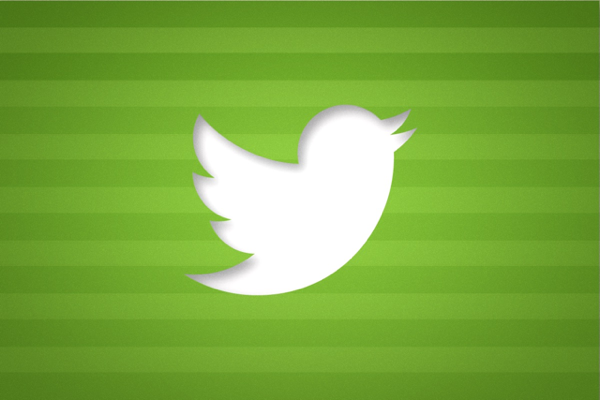Reposted
-
Everything doesn’t need a logo. In the 1990s, branding meant putting the logo on everything, but is it really necessary? (It isn’t.) Logos are important, but they aren’t the only way you communicate your identity. Apple’s using their logos smartly, and not over using their marks.
-
Differentiation happens with the design around the logo. Apple’s products are identified by their look and feel. Yes, the logo is part of that, but Apple’s visual branding extends far beyond just their logo. Their brand is expressed as much through the surrounding elements — type, color, materials — as it is through their logo. Their visual differentiation extends far beyond just their logo and their identity is stronger for it.
-
Think about how a visual identity can reflect a company’s values. Most of the time, visual identity reflects an organization’s structure, but connecting your visual brand to your corporate values is potentially more powerful. Apple uses logo variations that support their beliefs, not their hierarchy.
-
I don’t know why you spend so much time on those captive social sites.
-
I’m going to focus on open social platforms like Micro.Blog and limit the time I spend on captive social sites like Facebook and Twitter.
-
Hopefully, open social platforms will have the same impact on the web that the open web standards movement did.
-
I recognize that the concept of an open social network from a large corporation might seem absurd in today’s environment, but you never know. ↩︎
- Set a specific goal.
- Figure out a test to measure it: a survey, a timer, a standardized test, etc.
- Make sure everyone knows how important the test is.
- Provide rewards for people who achieve the test objectives. And penalize people who don’t meet the test objectives.
- Smart people will eventually figure out how to do well on the test, even if it now has nothing to do with the original goal.
- Management pats themselves on the back for great test results.
- The test no longer reflects reality.
- Engineers design products (cars, cell phones, etc.) that meet specific test objectives, but not real life usage.
- Customer service reps in banks, car dealerships and retail stores remind you over and over to answer “highly satisfied” on a random survey.
- Teachers teach to the test.
- Managers make short sighted decisions to stay under budget.
- Advertisers make really annoying online ads to improve click through rates.
- Fast food workers fake drive thru response times.
-
I’m a VW owner. My car is not a diesel, but I doubt that I’ll buy another Volkswagen even though I’ve been happy with my car… ↩︎
The Curious Case of the Missing Apple Logo
Two notable logo trends from Apple
This post was originally posted on April 22, 2021 on Sketchbook B. It’s reposted here as part of a project to move some of my favorite writing to my new site.
Apple has one of the most recognizable logos in the world. Which isn’t surprising because they are the largest company in the world. I’ve been watching a couple of trends over the last few months about how Apple uses their logos and this week, those trends have become even more apparent. For brand managers and designers, I think there is something interesting going on and it’s worth digging into the mystery.
The logo is “missing.”
Apple isn’t afraid to use their logos. All of their computers have prominent logos. They include logo stickers in all of their boxes. Apple’s logo is everywhere. But on their new iMac, which was released this week, Apple’s logo is on the back, but not on the front. The last few generations of iMac’s have featured a prominent logo on the back and a second logo on the “chin,” facing the user. The new iMac has no user facing logo.1
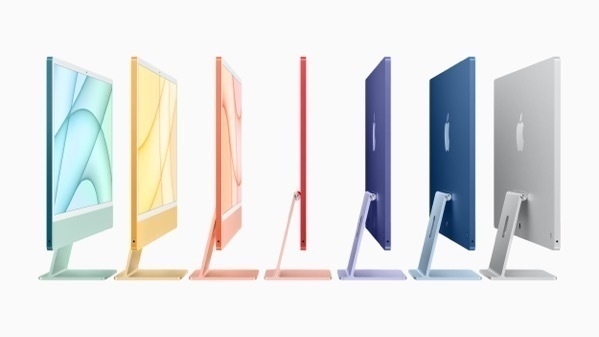
But the iMac isn’t the only recent Apple product with an interesting logo story. I first noticed Apple’s changing logo use with the introduction of the AirPod Max, which has no Apple logos at all on the product. There is plenty of room for a logo on the side of the headphones, but there is none to be found.

I guessed the AirPods Max was the only Apple product without a logo, but I was wrong. For some reason I assumed that my AirPods case had the Apple logo on it, but guess what? It doesn’t. I checked Apple’s website and the AirPods Pro don’t have a logo either. (Although according to Apple’s website and an iFixit teardown, the chip inside the AirPods Pro has a tiny logo printed on it.) My Apple Watch has a tiny Apple logo on the bottom on it, but it’s not visible when it’s being worn. Apple doesn’t include logos on any of their wearable products.2

But that’s not all. I’ve been trying out Apple Fitness+ and there are tons of visible logos. Nike logos. All of the instructors seem to be wearing Nike gear. There are no Apple logos. No special Apple Fitness+ shirts. No little Apple “watermark” in the corner of the screen. An Apple logo isn’t hidden somewhere on the set.

I checked Apple’s competitors. Amazon, Samsung and Microsoft all include their logo on the charging case for their AirPod competitors. Sony and Google even managed to get their logo on the earbud itself. None of the competing smartwatches that I looked at had logos, although Samsung etched “Galaxy Watch” into the crown for some reason.
In the fitness space, Peloton employees sport logo apparel while they lead classes. And the instructors on Nike’s fitness apps obviously sport Nike gear.
So what’s going on? I’m not sure.
My first reaction is it’s just an issue of taste. Placing logos all over a product is tacky — especially for wearables. And Apple is showing their superior taste by acknowledging that consumers don’t always want to be sporting company logos. Maybe? But lots of premium and luxury brands include logos on their products. And Apple isn’t exactly shy about using their logo.
It’s not about the logo size. Even the Apple Pencil has a logo. And as I mentioned, the chips inside the AirPods have logos printed on them. (The chips… inside the case… that the consumer never sees…)
The absence of a logo is even stranger when you realize the original intent of a trademarked logo: to clearly identify the manufacturer. With a company like Apple, whose designs are ripped off more than about any other tech company, their logo is the part of the design that absolutely can’t be legally copied.
My best guess is that Apple thinks that their product designs are unique enough, that they don’t even need a logo. People will know AirPods are an Apple product when they see them. The Apple Fitness+ workouts feel like Apple even if their logo isn’t present. I don’t think any other company can make a desktop computer that looks like the new iMac. Apple’s presence is understood because of the overall production quality and design. A logo isn’t necessary.
The logo is “incognito.”
Typical corporate logo standards are incredibly strict. Apple doesn’t publish their internal brand guidelines, but it’s clear they do allow some more playful uses of their mark. For example, they often use illustrated versions of their logo to promote their media events, like they did for this week’s Spring Forward event. Allowing logo variations in large corporate identity systems isn’t uncommon, but those variations are typically used for structural identifications between organizational divisions or product lines.
But Apple is using logo variants that align with their values.

In 2014, Apple started using a logo with a green leaf in their retail stores on Earth Day. This logo seems to be used mostly in Apple retail, but showed up this week on the Apple home page for Earth Day 2021 and their updated environmental statement.

And in this week’s presentation, they showed their privacy Apple variation, which is often animated and turns the leaf at the top of their logo into a lock. It’s used in ads, videos and sites when Apple is talking about their commitment to privacy. What’s smart about this approach is that Apple is using their logo to not just communicate their identity, but also their corporate values.
(It’s worth noting that there are a couple of other logo variants as well: a gift that is used during the holidays and a version for their Marina Bay Sands retail store in Singapore. And I’m sure there are others as well.)
What lessons can we take from Apple’s approach to logo management?
Apple’s visual branding is clearly effective. Repetition and consistency are the foundation of contemporary brand management, but Apple has decided to not use their logo in some places and change it in others. This ongoing shift in logo usage isn’t accidental or ill-considered. A couple of lessons to think about:
We’ll never hear from their branding team and Apple doesn’t publicly share their logo and branding guidelines. We’ll just have to watch as they rollout ads, events and products. But it’s clear that Apple is diverging from the standard brand playbook here and I think we should pay attention to where they go next.
Bob Wertz is a creative director, type designer, Ph.D. student and researcher living in Columbia, South Carolina. He’s been blogging since 2008.
Podcasts are the new special interest magazines
Detailed, up-to-date and authoritative

This post was originally posted on July 4, 2019 on Sketchbook B. It’s reposted here as part of a project to move some of my favorite writing to my new site.
I grew up loving magazines. Any time I’d be interested in something, I’d head to the magazine aisle in the bookstore or grocery store and look for magazines on the topic. Computers, cars, boats, science, model railroads, photography, sports, baseball cards, comics, design and more. It didn’t matter what I was interested in, there was at least one magazine on the topic.
Growing up in the pre-internet days, these magazines provided the info I was looking for. Detailed, up-to-date, authoritative info about whatever geeky habits I was interested in. Even the ads were informative and useful. I subscribed to some of them. Others, I’d buy if the main topics that month interested me.
The internet destroyed these publications. The first blow came from blogs. Authoritative people writing about the things they loved that people could read for free. The second blow was Google, which could route you to exactly what you were looking for. For various reasons — mostly related to monetization — the blog revolution failed to really take hold. Google’s search engine algorithm seemed to reward people with better SEO tactics over more authoritative sources. When I search Google for resources today, it’s hard to tell if what I’ve found is up-to-date or reputable. More often than not, I’m led to dated post of questionable origin that barely answers my question.1
I was excited about the introduction of Apple News+. Access to hundreds of magazines for $10 a month. The service is nothing world-changing. I’ve absolutely gotten my money’s worth and will continue to subscribe. Surprisingly, though, I discovered I’d already filled the need for a detailed, up-to-date, authoritative source for my geeky habits: podcasting.
I use podcasts the same way I used special interest magazines as a kid.
If I’m interested in a topic, I find a podcast. Computers, design, photography, business, pens, science fiction, pop culture, sports, meditation and more. I subscribe to many of these podcasts in Overcast2, while others I only listen to a few episodes. Even the ads are informative and relevant. Podcasts are how I learn about and explore new topics.
Some people think of podcasting as an evolution of talk radio. Others feel it’s more an audio form of blogging. I suppose I don’t have an issue with either of those opinions, but for me, podcasts serve a vital role as a replacement for the special interest magazine.
Bob Wertz is a creative director, type designer, Ph.D. student and researcher living in Columbia, South Carolina. He’s been blogging since 2008.
Captive Social vs. Open Social
Language matters.
This post was originally posted on January 13, 2019 on Sketchbook B. It’s reposted here as part of a project to move some of my favorite writing to my new site.
I’ve been thinking a lot lately about the language we use to talk about social media and content creation on the web. And as I’m writing about social media — especially microblogging and the indie web movement — I feel like we need a phrase to refer to platforms like Facebook, Twitter, LinkedIn and others that try to lock in users and leverage their private data to sell more ads, compared to the other newer services with revenue models that are less interested in ad sales or lock in.
I know that we already use “indie” and “indie web” as a way to differentiate between the two approaches, but I’m not sure that meaning is clear to a broader audience.
I’m going to go with “captive social” and “open social.”
Captive Social. Social media networks and services that make money through advertising, leveraging their user’s private data. Captive social networks benefit from gathering as much data on their users as possible and using that data to sell more relevant ads to users. To be profitable, that also means that they benefit from having users spend as much time as possible engaged with their platform. Examples of captive social networks: Facebook, Instagram, Twitter, Linked In, Snapchat.
I think my time in the insurance industry has partially inspired this terminology. Captive insurance agents are contractually obligated to only sell products from a single vendor. But I think the term is appropriate for the relationships we have with social media platforms. We are locked into each service silo with very little interoperability between competing platforms.
Open Social. Newer social media networks that are aren’t interested in trapping your data. They benefit from interoperability and the sharing of data between services. Their profitability isn’t based on leveraging personal user data, but on the value you derive from the service.
The inspiration for the terminology isn’t open source, it’s open web standards. I was a Mac user during the years of Internet Explorer dominance — when you sometimes couldn’t access a web site if you didn’t have the right browser. The open web standards push in the early 2000’s freed us from that nightmare and led to expanded browser choice. I hope that open social can have a similar effect on social media that open web standards had on the web.
Open social does have a distinct meaning from indie web. Indie web aims to separate itself from the corporate web, but open social is not necessarily limited to only small companies and decentralized platforms. A large corporation could build an open social platform, as long as they weren’t profiting from trapping your data and locking you into their service.1 The difference isn’t the size of the provider, but instead, their goals, objectives and business models.
So here are a couple of examples of captive social and open social in context:
It’s a subtle change — a language shift that I think will help when we are having discussions with people who are concerned about privacy and the power of social media, but who aren’t comfortable hosting their sites or maintaining a server.
Bob Wertz is a creative director, type designer, Ph.D. student and researcher living in Columbia, South Carolina. He’s been blogging since 2008.
Design + Math
Designers don’t want to admit it, but math is important to the profession.

This post was originally posted on September 29, 2015 on Sketchbook B. It’s reposted here as part of a project to move some of my favorite writing to my new site.
My first class in graduate school was a quantitive research class and I really enjoyed the statistics side of things. As I’ve told my designer friends this, they typically respond with something along the lines of “Ugh. I became a designer so I wouldn’t have to do math.” I’m not surprised. I’ve heard the same from designers and students over the years, but I’m increasingly irritated by it for a few reasons:
Designers use math every day. I’m not sure where the myth that designers don’t need to understand math comes from, but it’s not true. I use math pretty much every day in my work. Especially geometry and algebra. Understanding foundational mathematical concepts makes you a better designer.
It steers talent away from the field. Let’s say you’ve got a talented high school kid, who also happens to be good at — or maybe even like — math. Tell them enough times that math isn’t important for designers and they’ll find a different career path. As an honors student, I was told repeatedly through school by well-meaning adults that I didn’t want to take art classes because they weren’t rigorous enough. As a result, I initially looked at options like architecture and engineering. It took me a while to circle around to design.
It undermines the profession. The reality is that designers struggle to be taken seriously by big business. We’ve fought to get a “seat at the table” and prove our value beyond just crafting the look and feel of something. As much as we don’t like it, the “language” of business is often based in math. Ignoring the importance of math simply makes it harder to communicate with business decision makers.
I think the challenge is separating our feelings about “math class” from our feelings about “math.” I didn’t enjoy most of my high school math classes. My algebra and geometry teachers weren’t my favorites. Because I scored a high enough score on my AP Calculus test, I was able to exempt all of my college math requirements, so I haven’t taken a math class in almost 25 years. What I’ve come to realize is that while I disliked the way I was taught math, math itself is pretty amazing. And useful.
Don’t misunderstand me… I’m not expecting designers to line up and take refresher math classes. AIGA chapters aren’t going to start holding day-long math workshops. All I’m saying is that embracing the idea that math is an integral part of design only helps the profession as a whole.
Bob Wertz is a creative director, type designer, Ph.D. student and researcher living in Columbia, South Carolina. He’s been blogging since 2008.
The parable of the third soap dispenser
It never runs out of soap…

This post was originally posted on August 9, 2018 on Sketchbook B. It’s reposted here as part of a project to move some of my favorite writing to my new site.
The bathroom at my office has four sinks and three soap dispensers. Each soap dispenser has a clear plastic front so the cleaning crew can see how much liquid pink soap is left and refill it if necessary.
Sometimes, the first two soap dispensers are low on soap, but the last one, furthest from the door never seems to be low on soap.
You could draw conclusions from this single data point that no one uses the dispenser. And you would be right.
But why? Maybe people prefer the sinks closer to the door? Maybe it’s not in the most convenient location? Maybe there are too many soap dispensers?
The soap dispenser is broken. It hasn’t worked in at least 8 months.
But I imagine the cleaning crew has no idea. They are only looking at that one indicator: Is there soap in the dispenser?
Just a reminder that often, our data tells us what’s happening, but not necessarily why.
Bob Wertz is a creative director, type designer, Ph.D. student and researcher living in Columbia, South Carolina. He’s been blogging since 2008.
I made a red velvet cake. And learned an important lesson about fear.
This post was originally posted on January 7, 2018 on Sketchbook B. It’s reposted here as part of a project to move some of my favorite writing to my new site.
I made a red velvet cake last week.
From scratch. It was a recipe that my mom made when I was growing up, but it was originally my Grandmother Wertz’s recipe. My grandmother died when I was very young, so to me, red velvet always makes me think of my mom.
My mom passed away almost 17 years ago. She taught me to cook many things, but this red velvet cake was not one of them. All I knew was that it was difficult, and that she messed up the icing the first time she tried to make it. I can make pretty much anything that she made, but I had never tried to make the red velvet cake. I’ll be honest – I was scared. Scared to fail. Afraid that if I messed it up, I wouldn’t have someone to call for advice. I was on my own. So I never attempted it.
A few weeks ago, I started thinking about making her red velvet cake. I don’t know what triggered my urge to bake the unbakeable, but I couldn’t get the idea out of my head. I got the recipe from my sister and decided to bake the cake Christmas Eve. (Because obviously, we had nothing else to do that night…) I ran to the grocery store and got the ingredients. I found our fanciest cake stand. And I pulled out the Kitchen Aid mixer that my parents gave us as a wedding gift.
The recipe wasn’t that hard, but like most older recipes, it was procedural. Lots of steps and precise measurements. The cake batter came together okay, but the icing was another story. This recipe doesn’t use a cream cheese icing like a lot of modern red velvet cakes do. It’s more like a butter cream. I ruined the first batch of icing and had to make a second batch. About 1:00 Christmas morning, I finished icing the cake. It looked exactly like I remembered.
Christmas evening, after dinner, we cut into the red velvet cake – giant pie-sized wedges like my mom used to cut. It tasted like I remembered. Not too sweet, perfect texture. Even the kids loved it. I will freely admit that I teared up a little upon realizing that I had successfully pulled it off.
As I think about the year ahead, I realize that many of the things I’ve been scared of… many of the things I’ve put off attempting… the fear is all in my head. In 2018, I’m going to put those fears aside, branch out and try new things.
(And now that I can make the red velvet cake, I’m definitely going to bake it again.)
Bob Wertz is a creative director, type designer, Ph.D. student and researcher living in Columbia, South Carolina. He’s been blogging since 2008.
“You choose your dysfunction.”
I’ve used this phrase for years to describe changing jobs. Maybe I was wrong…
This post was originally posted on May 8, 2017 on Sketchbook B. It’s reposted here as part of a project to move some of my favorite writing to my new site.
Every place we work has its own dysfunctional elements. And when you change jobs, you move from one group of challenges to another. Every job has challenges. You choose which challenges you’ll face.
I had coffee a couple of months ago with some friends and one of them was in the midst of a job search. I relayed my standard “choose your dysfunction” advice. One of our friends piped up:
“I don’t know. I think that sometimes, we bring our dysfunction with us."
I still haven’t been able to get that thought out of my head.
Yes, it’s true that each job brings unique challenges. But it’s equally true the we cause many of our own issues. Too often, we blame the environment around us for something that we, ourselves, are causing.
The key to addressing those issues – to finding happiness or fulfillment or whatever you are looking for – is being able to tell the difference between the dysfunction you find and dysfunction you carry with you.
Bob Wertz is a creative director, type designer, Ph.D. student and researcher living in Columbia, South Carolina. He’s been blogging since 2008.
ASAP: The lowest priority

This post was originally posted on September 12, 2016 on Sketchbook B. It’s reposted here as part of a project to move some of my favorite writing to my new site.
Real jobs have deadlines.
As a designer, I hear “As Soon As Possible” an awful lot. Most people are shocked to learn that ASAP is actually my lowest priority. Jobs with concrete deadlines are always in line ahead of jobs with no real deadline.
Understanding why the client needs something ASAP is the first step in understanding whether you are dealing with a crisis or a “crisis.” There are a couple of reasons why clients avoid giving you a real deadline:
When can you get it to me? If the client is asking you to set a deadline, the project probably doesn’t have a firm due date. It likely needs to be done quickly, but they don’t want to look stupid and throw out a date that is impossible. Or they are hesitant to suggest a date that is too far out in the future. So they throw it back to you. In that case, sit down and start developing a schedule that works for everyone. If they need it faster, they’ll let you know in the process of setting the timeline.
Everything is a rush! For some clients, everything is a rush. Every email is marked high priority. So don’t overreact and rush into the project. Ask for a specific timeline. This is client’s normal operating procedure so stick to yours. If it’s a real rush, they will tell you.
It’s going to take forever! Some clients have no idea how long a project is going to take. So they are anxious to get started. Asking for a deadline will diagnose that immediately. I once had a client call in a panic and rushed over to meet them only to find out that we had four months to complete a simple poster series. Crisis averted.
My boss wants it now! Sometimes, the client is panicked because their boss is on their back. They may not even know when the project is really needed. Work with them to set a schedule to share with their manager. Have them confirm the schedule will meet the manager’s needs and get back to you. 99% of the time, the manager will be fine with the schedule.
I need it yesterday! Some clients ask for the world. And the ability to travel back in time. Setting a timeline is important here, but so are problem solving skills. I’ve seen clients ask for 50,000 brochures on a very short turn, only to find out it was because they needed 1,000 for a trade show. (We ran the 1,000. Then ran the larger print run later.) The clients are typically panicked and aren’t thinking straight. By focusing on the timeline, you can help them figure out what they really need and give them the best solution for their problem.
Sometimes, the client really is asking for the impossible. Tell them. But here’s the key, after you tell them that you can’t meet their deadline, tell them what you can do for them.
Oops! Sometimes the client makes a mistake and forgets to make a request or communicate a deadline. And this is where you can play the hero. Set a timeline for how to get them what they need and do your best to help them out.
Designers drop the ball sometimes, too. If it’s your fault, apologize and own the mistake. Then, move heaven and earth to make it right.
In every single one of these scenarios, communication is key. Be up front about the schedule, challenges and costs. Remember that the client is often under a lot of pressure and may not be thinking straight. Most importantly, don’t take the ASAP request personally. Just view it as what it is… an opportunity to save the day and build a better relationship with your client.
Bob Wertz is a creative director, type designer, Ph.D. student and researcher living in Columbia, South Carolina. He’s been blogging since 2008.
i dont care about my business @gmail.com

This post was originally posted on March 23, 2016 on Sketchbook B. It’s reposted here as part of a project to move some of my favorite writing to my new site.
All professionals need a personalized email address and a home on the web. And Gmail accounts and Facebook pages don’t count.
I saw a branding consultant recently without a branded email address. Who hires a brand consultant who doesn’t invest in their own brand? I saw a company trying to recruit managers… just email an AOL account. (In case you are wondering, the company wasn’t recruiting for AOL.) I was trying to find out information on a store in town and all they had was a Facebook page that hadn’t been updated in a couple of months. I don’t really care what your business is — from a home-based business to a large corporation — if you don’t have a real email address with your own domain name, I’m less likely to take you seriously. And if your only web presence is a Facebook page, you don’t have a real business.
Look. I get it. It’s easy to get by with the free accounts. A penny saved is a penny earned. Absolutely. But investing in a domain name and a Google apps account? It’s not that expensive. Without your own domain, you send a message to all your clients and potential clients that you can’t or won’t invest in your own company.
It used to take some effort to get on the Web a decade ago, but now, services like Squarespace provide great solutions for small businesses and take care of hosting, e-commerce and more. Like Gmail? That’s fine. You can customize your address with Google Apps. Other services like Hover can help you get your domain and email set up. There are seriously hundreds of services to help you look professional. It’s not that hard and not that expensive.
Having a professional online appearance is every bit as important as dressing appropriately or speaking intelligently. It’s a necessary investment that lets people know that you are serious about your business.
Unless you aren’t serious about your business. And then, I guess, any email address or website will do.
Bob Wertz is a creative director, type designer, Ph.D. student and researcher living in Columbia, South Carolina. He’s been blogging since 2008.
What it’s like to have three kids…
This post was originally posted on November 13, 2015 on Sketchbook B. It’s reposted here as part of a project to move some of my favorite writing to my new site.
I get asked a lot what it’s like to have three kids. Mostly from people with two kids thinking about whether they want to have another. Sometimes, the question comes from younger couples who are thinking about having kids.1 And I always struggle to answer.
My standard answer is that when you have three kids, you have to switch from man-to-man to zone. You lose a little control. You are outnumbered. And while that is completely accurate, it sounds scary and intimidating, which isn’t at all what I want to communicate. I love having three kids.
My other answer is that with three kids, how far apart they are really matters. I’ve had friends with three kids under four years old. For us, our oldest was seven when her brother was born. Those are two radically different situations. But that doesn’t really answer the question.
Sunday morning, an interaction with the kids gave me the answer I was missing. We were waking up and getting ready for church.
Middle child: What are we doing for breakfast?
Me: I don’t know. We’ll probably have a small breakfast now and maybe go to brunch after church.
Youngest: WHAT! We can’t go to a restaurant! We need to go to church! (He LOVES Sunday School.)
Me: We are going to church. We might go out to eat after church.
Youngest: Why can’t we eat at church?
Me: Because they aren’t serving breakfast at church.2
Oldest (from another room): We’re having breakfast at church?!?
And that’s what it’s like having three kids — like adding a person to a game of telephone. It gets a little bit crazier. Funnier. Unpredictable. Often delightful and occasionally frustrating. But never boring.
Bob Wertz is a creative director, type designer, Ph.D. student and researcher living in Columbia, South Carolina. He’s been blogging since 2008.
You get what you test for…

This post was originally posted on September 29, 2015 on Sketchbook B. It’s reposted here as part of a project to move some of my favorite writing to my new site.
A few years ago, I stopped at a fast food restaurant in rural, upstate South Carolina where a car was circling the drive thru over and over and over. She’d drive up to the ordering station and wait a second. Then the car would drive to the window, pause, and then drive around again. This happened a couple of times. It was very strange.
When I walked in, I nodded toward the car at the window and asked what was going on. The woman shrugged, obviously embarrassed, and said “Just improving the drive thru wait times…”
Lots of people wonder how something like the Volkswagen 1 emissions test scandal can happen. It’s actually very simple:
This cycle is everywhere in business today and manifests itself in different ways. Most of the time, it doesn’t involve fraud and cheating. But this process is why:
If you connect success on a metric to an employee’s financial well being, that employee will change their behavior to meet the test objectives. And yes, sometimes, if the pressure is great enough, they cheat.
I’m sure those fast food workers wanted to have good drive thru response times to make their boss happy. I doubt there was a financial incentive. Maybe if the boss was happy, their life would be easier. Or perhaps they were afraid of being fired. Whatever the reason, they cheated to meet their test objectives. They lost sight of — or more likely, were never told — the reason for the test.
The test itself isn’t the problem. Testing and evaluation is a key part of management in a corporate environment. But today, it’s really easy to test and measure everything. Over reliance on metrics in management makes the test more important than the goal. And that never ends well.
You’ll simply get what you test for.
Bob Wertz is a creative director, type designer, Ph.D. student and researcher living in Columbia, South Carolina. He’s been blogging since 2008.
B.A.R.E. (Bad Acronyms aRe Everywhere)
This post was originally posted on May 14, 2015 on Sketchbook B. It’s reposted here as part of a project to move some of my favorite writing to my new site.
Why are so many people and organizations obsessed with acronyms? Especially acronyms that spell another word. From small nonprofits and churches to schools and large corporations, really bad acronyms are everywhere.
NASA’s Messenger Probe crashed into Mercury after a long and successful mission. And as I read CNN’s account of the mission, I was stunned by the fifth paragraph:
Messenger (an acronym for MErcury Surface, Space ENvironment, GEochemistry, and Ranging) was launched in 2004 and traveled more than 6½ years before it started circling Mercury on March 18, 2011.
Wait. So the Messenger probe is actually M.E.S.S.E.N.G.E.R.? Or is it Me.S.S.En.Ge.R.?
NASA designed a space probe to fly to a planet named after the messenger of the gods. And NASA feels like they need to construct some bogus acronym to justify the name “Messenger.”

Acronyms are fine if they really help people remember and understand the program or product name. But in most cases, the acronym simply becomes a name and slowly loses all connection to the meaning.
And the worse case scenario is that you are so obsessed with creating an acronym, that you select a poor name in the process. Avoid creating acronyms just to be clever or just to justify a name choice.
Your best bet is always to give products, organizations and programs strong, appropriate names.
–
Bob Wertz is a creative director, type designer, Ph.D. student and researcher living in Columbia, South Carolina. He’s been blogging since 2008.
Fuzzy PowerPoint Math
This post was originally posted on August 5, 2013 on Sketchbook B. It’s reposted here as part of a project to move some of my favorite writing to my new site.
A little math problem for you…
One 15-minute PowerPoint1 presentation has 5 slides. Another 15-minute PowerPoint presentation has 15 slides. Which presentation is shorter?

Obviously, both are 15-minute presentations. They are the same length.
But time and again, I talk to people who reduce the number of slides in their PowerPoint because they want to make the presentation “shorter.” They think that if they have fewer slides, they will talk for a shorter amount of time. Often, they don’t take material out, as much as they condense it on the remaining slides.2
That’s completely the wrong way to think about it.
Next time you have a presentation, think about how long you have to present and build your story to fill the allotted time. Then create an appropriate number of slides to support your presentation. You may have more slides and move through them quickly. Or only a handful of slides.
But remember that the length of your presentation has almost nothing to do with how many slides you have.
Bob Wertz is a creative director, type designer, Ph.D. student and researcher living in Columbia, South Carolina. He’s been blogging since 2008.
Evolving Screen Design: Star Trek and the Viewscreen
This post was originally posted on June 1, 2009 on Sketchbook B. It’s reposted here as part of a project to move some of my favorite writing to my new site.
One of the defining design characteristics of a ship in the Star Trek Universe is the forward viewscreen. And in the J.J. Abrams reboot of Star Trek, the entire concept of the viewscreen has also been reimagined.
By looking at how our vision of the future has evolved, we can often learn more about how we as a society have changed. And I think by looking at how the concept of the viewscreen has changed over the last four decades, I think we can draw some conclusions about how we have changed as culture and where we are going.
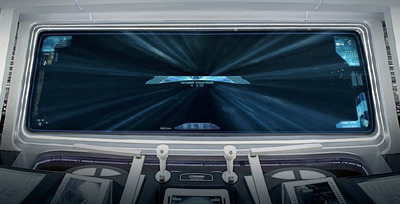
The Original Viewscreen
In Gene Roddenberry’s original Star Trek TV Show, the view screen was primarily a giant screen showing the outside. Very rarely, the screen would be used to show scientific data.
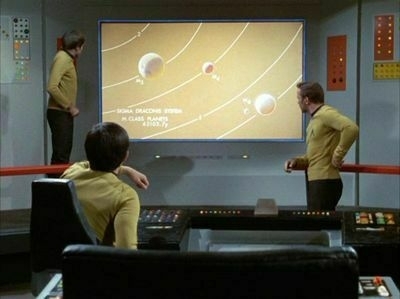
At the time, in the late 60’s, that concept was enough to seem futuristic. TV’s were still a relatively young technology. A screen that size providing live pictures with the ability to show content from the ship’s computer… That was the future. Computers were room-sized devices with limited capabilities. The whole concept would have seemed very advanced.
The expectation was that interaction with a large viewscreen would be passive. It was something to watch, more like a TV than a computer interface.
To the big screen and back to the small screen
When the Star Trek series moved to the big screen in the late 70’s and into the 80’s, the viewscreen concept was only slightly refined. The expectation was still that the viewscreen provided a passive experience. Some odd touches were added, like a digital clock over the screen.
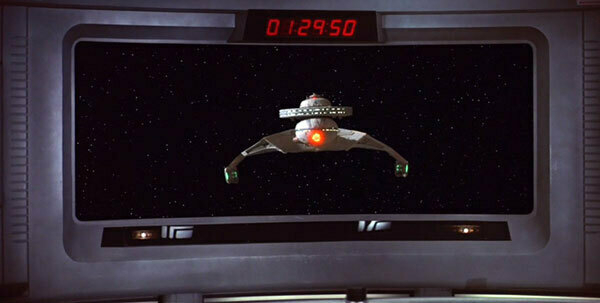
With the success of the movie franchise, Star Trek: The Next Generation launched into syndicated television. Because the series took place even further in the future, they took the established concepts and “enhanced” the technology. The viewscreen evolved, but only from a technical level. The screen was now “holographic.” (Note: I’m assuming this means the images were more realistic.)
The way the crew actually used and interacted with the screen was still passive and static. And through the three series that followed, the viewscreen never really did much more than provide pretty pictures.
Reimagining the Viewscreen
When Abrams and crew started work on the reboot, they faced a challenge of honoring the style of the past and while projecting a modern, futuristic feel:
We had the weird challenge of having to take a 43 year old vision of the future and make it a current vision of the future. I wanted the movie to feel as tactile and tangible and as real as possible, but given what our computer interfaces are like now, its preposterous to assume that hundreds of years from now there won’t be some version of holographic screens and things that seem almost ubiquitous now in science fiction.
-Abrams in an interview with Memory Alpha
We as a culture have evolved to expect more from our “viewscreens.” Many of our TV channels have crawls and information graphics. Look at what CNN produced during the elections or what ESPN News does on a daily basis. Our computers provide constant updates. Even our cars and phones have interactive interfaces. We expect modern screens to do more than just show us pictures. We expect them to inform us.
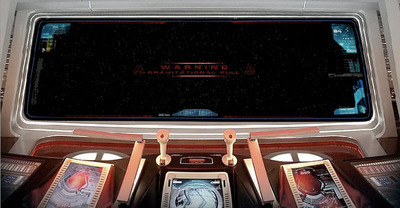
That old concept of a passive viewscreen has been discarded in the new Star Trek movie. The giant viewscreen acts as a heads up display for the ship. Warnings, current speed, the health of the away team, status of the ship and more appear over the top of the screen. And the information that is provided is contextual, only appearing when needed or applicable.
We have become a viewscreen culture
Looking at the new Star Trek viewscreen, it feels futuristic. And what that really means is that it feels like a radically advanced version of where we are now.
I think that we have become a viewscreen culture. We have become comfortable interacting with screens in a way that wasn’t comprehended in the late 60’s and wasn’t fully understood even in the 80’s and 90’s. In fact, we are more than just comfortable. We now expect our screens to provide us information and feedback.
As the web, digital television, phones and computers evolve, our cultural expectations of the screens and surfaces around us with continue to change and evolve. We as designers are already starting to see this. People expect more from their web sites and other digital interfaces. They expect these tools to interact with them. To provide the information they need when they need it.
What designers need to remember is that this is just the beginning. People will continue to become more and more comfortable with screen-based content. And we must continue to push the limits of the medium to provide the interaction and capabilities that our society is beginning to expect.
Bob Wertz is a creative director, type designer, Ph.D. student and researcher living in Columbia, South Carolina. He’s been blogging since 2008.

